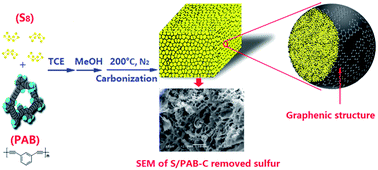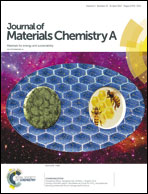Instantaneous carbonization of an acetylenic polymer into highly conductive graphene-like carbon and its application in lithium–sulfur batteries†
Abstract
To eliminate capacity fading effects due to the loss of sulfur in cathode materials for lithium–sulfur batteries (LSBs), a polymer of poly(1,3-diethynylbenzene) (PAB) with good solubility was synthesized by an oxidative coupling reaction. This polymer can be instantaneously carbonized into highly conductive carbon, which can then be used as both an immobilizer host and conductivity enhancer for sulfur cathodes. The cathode material of S/PAB-C was prepared via a rapid dissolution–precipitation method combined with an in situ and instantaneous carbonization process to obtain 3D graphene-like PAB-C with an artificial honeycomb-like morphology. Benefitting from this particular design, the S/PAB-C cathode with an optimal content of 75% sulfur exhibits excellent discharge–charge performance, which shows initial discharge capacities of 1449 mA h g−1 at 0.1C and 1087 mA h g−1 at 0.5C, and retains a stable capacity of 900 mA h g−1 after 500 cycles with a high retention of 82.6% at 0.5C. The strategy which utilizes instantaneous carbonization of PAB and an in situ sulfur trapping process offers a new way to enhance the cycling stability and enriches the architectural design of LSBs. To the best of our knowledge, this is the first report about the brand new methodology to in situ synthesize highly conductive carbon for application in LSBs.



 Please wait while we load your content...
Please wait while we load your content...